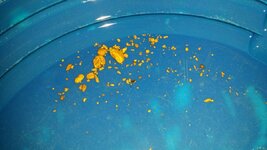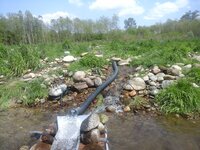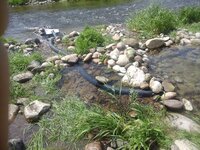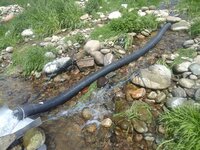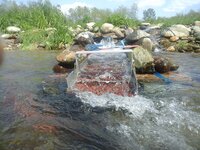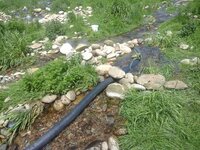brobronek
Jr. Member
- Jun 19, 2013
- 50
- 46
- Detector(s) used
- Bazooka Gold Trap 36'' prospector
jobe folding sluice box
Garrett Pro-Pointer AT (carrot)
fisher gold bug
- Primary Interest:
- Prospecting
hi guys, it is pretty simple.
i metal detect, river snipe, pan, sluice and lately decided to modify my JOBE folding sluice box and try gravity dredging.
sluice modification:
i doubled the size, added a self classifier, some rubber corrugated matting under it for the fine gold recovery, 6 extra adjustable feet
I use 100 feet of 3 inches plastic pipe having at least 10+ feet drop
1)The first hard job was filling up the pipe to let the gravity do the job... it took me some time but was achieved.
Any fast and secure way to fill it up will be great?
2) my sluice box had i believe enough water going through it but a slight drop but was jamming after an hour or so with light rocks and send.
it catches gold but i would like to have the light stuff go with the water in order to work longer before clen up.
so please if you can have a look at the video and give me your thoughts.
this is the first gravity dredging video so others will be posted for some follow up. and better videos i will try
i will try
cheers everyone
https://youtu.be/r-UkVYrbuYY
i metal detect, river snipe, pan, sluice and lately decided to modify my JOBE folding sluice box and try gravity dredging.
sluice modification:
i doubled the size, added a self classifier, some rubber corrugated matting under it for the fine gold recovery, 6 extra adjustable feet
I use 100 feet of 3 inches plastic pipe having at least 10+ feet drop
1)The first hard job was filling up the pipe to let the gravity do the job... it took me some time but was achieved.
Any fast and secure way to fill it up will be great?
2) my sluice box had i believe enough water going through it but a slight drop but was jamming after an hour or so with light rocks and send.
it catches gold but i would like to have the light stuff go with the water in order to work longer before clen up.
so please if you can have a look at the video and give me your thoughts.
this is the first gravity dredging video so others will be posted for some follow up. and better videos
 i will try
i will trycheers everyone
https://youtu.be/r-UkVYrbuYY


